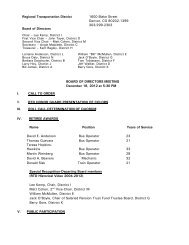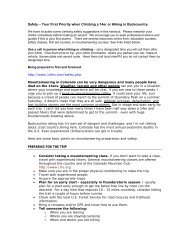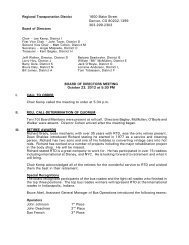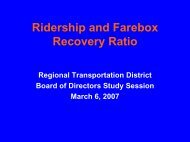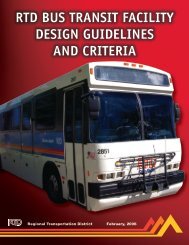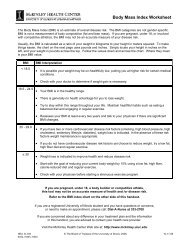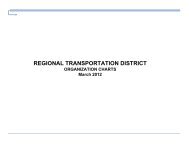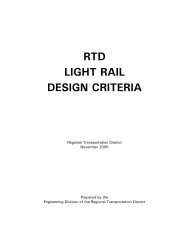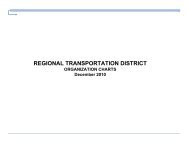Commuter Rail AC Electrification Load-Flow Simulation Report - RTD
Commuter Rail AC Electrification Load-Flow Simulation Report - RTD
Commuter Rail AC Electrification Load-Flow Simulation Report - RTD
You also want an ePaper? Increase the reach of your titles
YUMPU automatically turns print PDFs into web optimized ePapers that Google loves.
<strong>Commuter</strong> <strong>Rail</strong> <strong>AC</strong> <strong>Electrification</strong> <strong>Load</strong>-<strong>Flow</strong> <strong>Simulation</strong> <strong>Report</strong> Revision 1<br />
3.0 TYPICAL AUTOTRANSFORMER-FED SYSTEM CONFIGURATION<br />
3.1 GENERAL<br />
This Section of the report discusses common features of typical modern autotransformer<br />
systems and their application in general. More specific requirements and recommendations<br />
applicable to Denver <strong>RTD</strong> autotransformer system are discussed in Section 9.0 – Conceptual<br />
Design of the Denver <strong>RTD</strong> Traction <strong>Electrification</strong> System. The Traction <strong>Electrification</strong> System<br />
(TES) will provide electrical power to the trains by means of the traction power supply system,<br />
traction power distribution system, and traction power return system. Each system is comprised<br />
of the following:<br />
• Traction Power Supply System - includes traction power substations located along the<br />
route at predetermined locations.<br />
• Traction Power Distribution System - consists of the overhead catenary system, feeder<br />
system, paralleling stations, switching stations, and isolating switches.<br />
• Traction Power Return System - comprises of the running rails, impedance bonds,<br />
cross-bonds, static wires, grounding connections, and the ground (earth) itself.<br />
The traction power substations normally receive electrical power from the local utility company<br />
at high voltage, 115 kV or 230 kV. The substation traction power transformers step-down the<br />
power to 50 kV with the center point of the secondary winding grounded and connected to track<br />
rails. Such arrangement provides two 25 kV voltages on the secondary windings suitable for<br />
supply to the feeder/catenary system. The trains will collect their propulsion power from the<br />
overhead catenary system by means of pantographs and return the power to the substations via<br />
the running rails which are a part of the traction power return system.<br />
3.2 TR<strong>AC</strong>TION POWER SUPPLY SYSTEM<br />
3.2.1 Utility Power Supply<br />
For economic reasons, the traction power substations should receive power directly from the<br />
power utility high voltage substations or transmission lines located in close proximity to the rail<br />
corridors.<br />
Connections to the utility high voltage system is required to ensure optimal supply reliability and<br />
to limit voltage flicker, phase unbalance, and harmonic distortion that may result from the<br />
addition of the highly fluctuating, single-phase, and non-sinusoidal traction loads.<br />
It is desirable to supply the traction power substations by two high voltage lines that are as<br />
independent of each other as possible.<br />
3.2.2 Substation Type and Equipment<br />
The traction power substations transform the utility power from high voltage of 115 kV to the <strong>AC</strong><br />
electrification system utilization voltage of 2x25 kV. The substations will include all the<br />
necessary equipment in order to transform and control the <strong>AC</strong> voltage between the utility<br />
company and the traction power system which is used by the rolling stock.<br />
02/27/2009 FRSC Page 6 of 250




